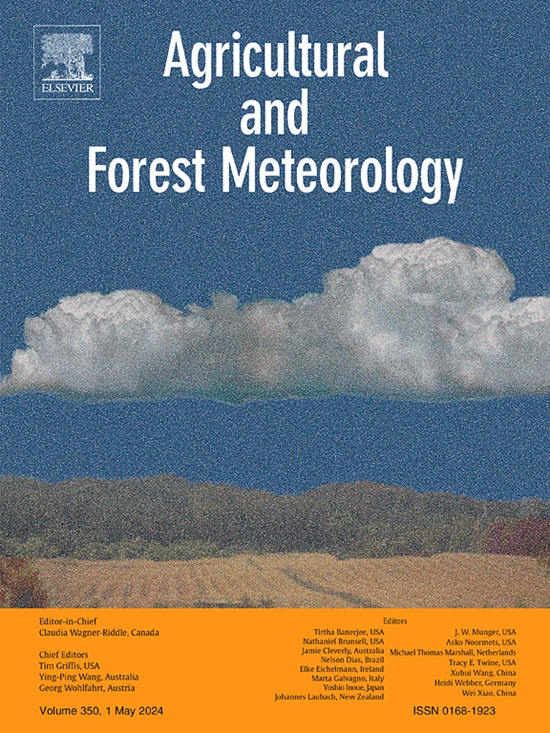油蒿灌丛生态系统林冠和生态系统水分利用效率对环境条件的差异响应
IF 5.7
1区 农林科学
Q1 AGRONOMY
引用次数: 0
摘要
林冠和生态系统水分利用效率(WUET和WUEE)分别在林冠和生态系统尺度上衡量碳增益和水分损失之间的权衡,为旱地水资源管理提供重要信息。但旱地水净蒸发量和水净蒸发量在年代际尺度上的环境控制评价仍然有限。利用涡动相关(2014-2023)和流量测量(2022-2023),研究了中国北方以油蒿为主的灌丛生态系统中WUET、WUEE及其组分(即生态系统生产总量GPP、蒸散发ET和蒸腾T)的环境控制因素。结果表明,由于GPP和T对环境因子的响应相似,WUEE(变异系数,CV= 12.5%)的年际变化大于WUET (CV= 8.2%)。因此,WUET的年际变化似乎不受冠层绿度(即归一化植被指数NDVI)和气候因子(土壤含水量SWC和水汽压亏缺VPD)的影响。而WUEE的年际变化主要受NDVI的控制,通过改变T / ET的比值。GPP和ET的年际变化受春季SWC的显著影响,其影响了夏季冠层绿度(NDVI_summer)。我们进一步发现,SWC的减少并不普遍与GPP和ET的减少相关。相反,在整个SWC范围内,GPP和ET对VPD增加的敏感性始终为负。结果表明,林冠水分利用效率对环境因子的响应并不一定反映林冠水分利用效率的变化。尽管VPD主要强调GPP和ET,但SWC是决定GPP和ET年际变化的关键因素,在研究GPP或ET的长期趋势时需要考虑SWC。本文章由计算机程序翻译,如有差异,请以英文原文为准。
Divergent responses of canopy and ecosystem water use efficiency to environmental conditions over a decade in a shrubland ecosystem dominated by Artemisia ordosica
Canopy and ecosystem water use efficiency (WUET and WUEE) measure the trade-off between carbon gain and water loss at canopy and ecosystem scale respectively, and provide vital information for water resource management in drylands. But the assessment of environmental controls on WUET and WUEE on the decadal scale in drylands remains limited. Here, using eddy covariance (2014–2023) and sap-flow measurements (2022–2023), we investigated the environmental controls of WUET, WUEE, and their components (i.e. gross ecosystem production GPP, evapotranspiration ET, and transpiration T) in a shrubland ecosystem dominated by Artemisia ordosica of northern China. Results showed that WUEE (variation coefficient, CV=12.5 %) exhibited a larger interannual variation than WUET (CV=8.2 %), due to similar responses of GPP and T to environmental factors. As a result, the interannual variation in WUET seems to be independent of both canopy greenness (i.e. normalized difference vegetation index NDVI) and climatic factors (soil water content SWC and vapor pressure deficit VPD). While interannual variation in WUEE was mainly controlled by NDVI through changing the ratio of T to ET. The interannual variation in GPP and ET was significantly affected by SWC in spring, which impacted canopy greenness in summer (NDVI_summer). We further found that a decrease in SWC is not universally associated with reductions in GPP and ET. By contrast, the sensitivity of GPP and ET to an increase of VPD is always negative across the full SWC range. Our results suggested that the response of WUEE to environmental factors does not necessarily reflect changes in canopy water use efficiency. Despite the predominant VPD stress on GPP and ET, SWC is a key factor in determining interannual variation in GPP and ET and need to be taken into account when studying long term trends in GPP or ET.
求助全文
通过发布文献求助,成功后即可免费获取论文全文。
去求助
来源期刊
CiteScore
10.30
自引率
9.70%
发文量
415
审稿时长
69 days
期刊介绍:
Agricultural and Forest Meteorology is an international journal for the publication of original articles and reviews on the inter-relationship between meteorology, agriculture, forestry, and natural ecosystems. Emphasis is on basic and applied scientific research relevant to practical problems in the field of plant and soil sciences, ecology and biogeochemistry as affected by weather as well as climate variability and change. Theoretical models should be tested against experimental data. Articles must appeal to an international audience. Special issues devoted to single topics are also published.
Typical topics include canopy micrometeorology (e.g. canopy radiation transfer, turbulence near the ground, evapotranspiration, energy balance, fluxes of trace gases), micrometeorological instrumentation (e.g., sensors for trace gases, flux measurement instruments, radiation measurement techniques), aerobiology (e.g. the dispersion of pollen, spores, insects and pesticides), biometeorology (e.g. the effect of weather and climate on plant distribution, crop yield, water-use efficiency, and plant phenology), forest-fire/weather interactions, and feedbacks from vegetation to weather and the climate system.

 求助内容:
求助内容: 应助结果提醒方式:
应助结果提醒方式:


